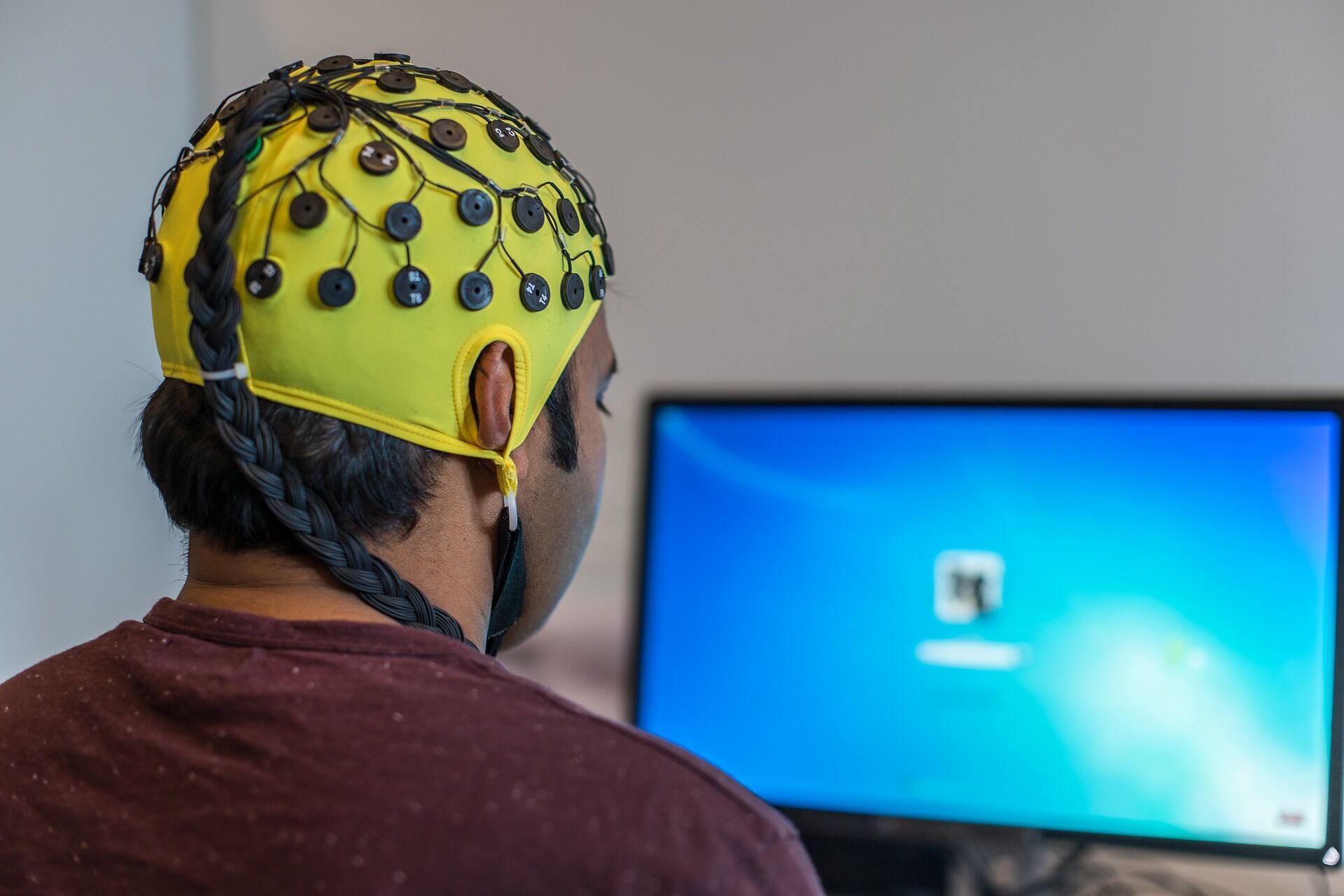Neuromarketing: A Marketer's Guide

- Summary
- What is Neuromarketing?
- What is Neuromarketing used for?
- Understanding Neuromarketing
- Benefits of Neuromarketing
- Criticisms of Neuromarketing
- Is Neuromarketing Manipulative?
- What Tools Do Neuromarketers Use?
- What Is Neuromarketing's Future?
- Neuromarketing: Further Reading
- Neuromarketing: Further Consultation
The term 'neuromarketing' conjures up images of being plugged into the Matrix by neuroscientists, Neo-style, your brain synapses and neural signals being measured for responses to the latest marketing materials as your neural pathways fuse with data-capturing spreadsheets.
Well, the truth is a lot less sinister – and it's a concept that's here to stay. So what exactly is neuromarketing?
In this article, we'll journey into the field of consumer decision-making and neuromarketing with you to explain what neuromarketing is. We'll unpack how you can use it positively to gauge and shift consumer behavior and provide some of the latest insights into consumer neuroscience.
From eye tracking to ethical issues and facial expressions to focus groups, we'll unpack the conventional techniques and traditional marketing research that have brought us to the point where we need to define neuromarketing.
We will also be peering into the future of marketing strategies that work with our neural responses and subconscious minds.
And who knows, perhaps we already are in the matrix! In which case, buckle up and enjoy the ride!
What is Neuromarketing?
Neuromarketing is an approach to understanding consumer behavior through the subconscious mind by measuring consumer responses to product design and marketing campaigns. It is also known as 'consumer neuro science' and aims to make marketing more effective.
Its beauty lies in bypassing the more traditional methods and marketing strategies of advertising campaigns taught in business school that relied on focus groups and consumer surveys to determine their efficacy.
Neuromarketing employs brain scans to measure brain activity in response to advertising campaigns or digital experiences, the most common being EEG and fMRI. An EEG (electroencephalogram or electroencephalography as it it is also known) uses electrodes (small metal discs) attached to people's brains to track neural signals.
FMRI stands for Functional Magnetic Resonance Imaging, and this neuroscience research technique measures our conscious and unconscious emotions and responses to advertising campaigns using an fMRI scan performed by an fMRI machine. It does this by tracking brain activity in deep parts of our brain in great detail, parts that we are just beginning to know what they are used for!

An obvious example that speaks to the efficacy of neuromarketing methods is the use of the color red by Coca-Cola in its logo. Impulse control in the human brain happens in the prefrontal cortex, and neuroscience proves that observing the color red significantly stimulates the appetite. All that prefrontal cortex activity made it a no-brainer (no pun intended) for Coca-Cola to splash out on red with their packaging when branding their sugary, black drink.
Gone are the days of test subjects sitting in a focus group, attempting to tell marketers with clipboards behind glass windows precisely what they do or don't like about a particular product.
With Functional Magnetic Resonance Imaging (fMRI), eye tracking (which also measures pupil dilation), and facial coding, we can use neuromarketing to measure emotional responses to marketing stimuli without consumers putting their responses into clumsy words.
The brain and subconscious mind provide hard data that intelligence companies trust in assessing consumer behavior and trying to better understand how to utilize accurate market research to deliver better products, services, and, indeed, authentic web content.
What is Neuromarketing used for?
Perhaps what's most exciting about neuromarketing is its democratization. Previously, if you were a big advertising agency working for one of the major corporations running a Superbowl ad, it would make sense for you to embrace the concept of neuromarketing in determining which version of an ad to run as you were already working with big budgets and high costs.
While expensive in nature, Facial expressions and blood flow are used to measure and determine emotional responses to marketing campaigns, providing clues and revealing the inner desires of the subconscious mind that can't be captured by filling in a form or collecting survey responses.
Nowadays, the potential benefits and ease of neuromarketing are more significant than ever before. Examples of neuromarketing’s success are especially evident in home industry packaging designs (start-up businesses), as well as where it provides insight into the demographic of online customers' preferences by measuring how quickly they are likely to click on something and the time it takes (ad efficiency) to convert that click into a sale.
Let's say you're running a promotion for your product using a price point and a marketing message about your brand. The displayed price and value proposition immediately force the consumer to determine your product's value.
If you want to emphasize the message about the brand rather than the price itself – to build an emotional connection with the brand in the subconscious mind – then neuromarketing techniques that include tracking eye movements and facial coding are the way to go.
They provide valuable market research on what users see first and how that affects the prioritization of the contents in the promotion.

Neuromarketing is also used to determine which brand a consumer prefers in a direct line-up between Coca-Cola and Pepsi, for example. Neuromarketing takes it a step further by measuring the milliseconds with which that person chose Coca-Cola over Pepsi, introducing a measurable, 'certainty' quotient.
Neuromarketing is now studied at the postgraduate level, with auditing and consulting firms such as Deloitte throwing their weight behind understanding customers' unconscious buying behavior (they've recently launched the Deloitte Neuroscience Institute).
Emory University in Georgia, US, has a Center for Neuropolicy that uses brain imaging technologies to understand human motivation and decision-making in business and politics. The Center for Applied Research in Decision Making (CARD) at Temple University in Philadelphia, US, was formerly known as the Center for Neural Decision Making.
Their focus is now on a more interdisciplinary approach, combining neuroscience research and multi-methodology better to understand attention, memory, desirability, and emotion. They are working predominantly in the fields of Information Systems, Marketing, and Management.
There seems to be a move, academically at least, to understand decision-making using the latest neurophysiological tools across all markets, industries, societies, and organizations.
Framed in this way, the term 'neuromarketing' appears somewhat limiting: the field is not concerned with studying the cognitive, sensorimotor, and affective response of the consumer alone – but rather that of all political and social agents.
Understanding Neuromarketing
Neuromarketing challenges marketers to ensure that their brand communication is forming a connection with each sense and both the logical and emotional brain. When you walk into a shop, for example, it's not just the price of a garment in the window that attracts your attention.
What you hear, smell, touch, taste, and see all form part of a sensory experience that stimulates your neural pathways and drives your subconscious choices.
With neuromarketing research, emotions are linked to preference, and unconscious feelings are related to conscious choice. Consumer attention span is taken into account through memory recall, and learning also plays a crucial role here.
Understanding how memories affect the relationships we have with brands on a subconscious level. And if so, how can we build positively on that?

The case study trotted out in academic circles is that of Frito-Lay chips. Neuroscience confirmed that a woman's hippocampus region of their brain (the memory and emotional center) was significantly larger than those of men, leading neuromarketing experts to draw the conclusion that women could process adverts with a higher degree of complexity.
The emotional reaction of guilt was considered a barrier for women wanting to snack on Frito-Lay potato chips. Healthy ingredients were instead featured on the packaging, and the increase in sales was a testament to the power of marketing in applying neuroscience to establish meaningful connections with a brand.
Neuromarketing is increasingly crucial in cracking the code of what a consumer wants and needs – allowing us digital marketers to weed out what doesn't work, as we battle to remain authentic in a sea of internet awash with clickbait and misinformation that often ends up deceiving or irritating online consumers.
By creating better customer understanding – not to mention improving the consumer experience – neuromarketing is proving itself to be a valuable sales strategy of the future.
Benefits of Neuromarketing
The benefits of neuromarketing are numerous. For starters, we can do away with the unconscious bias and conscious manipulation that tarnishes the behavioral data of research test subjects likely to give socially desirable answers in cumbersome marketing surveys and focus groups.
Because the brain signals being monitored in neuromarketing are unconscious, they're less susceptible to bias or manipulation.
What motivates and satisfies a consumer can now be measured without disturbing their consumer journey. Sales can also be increased by identifying the ideal price promotion strategy. A consumer's motivation to buy a product can now easily be identified, with EEG frontal alpha asymmetry proving effective as a tool.

A wearable recording device (similar to a pair of headphones) is worn on the head, identifying positive and negative emotions during the buying process. The interpretation of these brain signals provides insight into the unconscious factors that make up the decision-making process, cutting a swathe through more conventional economic deliberations.
Neuromarketing is not just beneficial in that it can identify promotions that motivate consumers to buy a particular product. It is also valuable for confirming some traditional methods using marketing efforts that worked – yet perhaps we weren't sure why.
'Social proof' is one of the main reasons that consumers will choose a particular product. Similar to the theory of crowd intelligence, a potential buyer is more likely to trust the buying decision of the majority when it comes to spending money on something new.
Neurological and psychological research has proven that a "bestseller" promotion will yield better results than a "50% off" campaign. Whereas a consumer may see themselves as rational and "price sensitive", EEG measurements confirm an implicit willingness to pay more for something that offers social proof of its popularity.
Explore How A Neuromarketing Agency Can Help You Predict Buying Patterns
Criticisms of Neuromarketing
Broadly speaking, the criticisms of neuromarketing are that the equipment is expensive and you need highly specific skills to garner high-quality marketing insights.
Some argue that neuromarketing is simply advertising masquerading as a science, and there are ethical concerns regarding the extent to which market research can tap into our subconscious and tell us things about ourselves that we don't already know (or necessarily want to, perhaps).
Related to this is the idea of brain privacy and the extent to which our primal brain should be protected from potentially invasive marketing campaigns that prompt more aggressive consumer behavior.
We would argue here that this ties into a broader debate on the value systems in place for all advertising and marketing companies – and we will address that now in greater detail as the topic deserves a more in-depth answer.
Is Neuromarketing Manipulative?
As humans, we are driven almost entirely by our subconscious, with neuroscience putting the percentile at 95%. That is the percent of brain activity that lies beyond our conscious awareness. Therefore, our purchasing decisions are also largely subconscious. And because our brain is making those decisions, it stands to reason that all marketing is neuromarketing, for all marketing is targeting our brains.
Is neuromarketing manipulative, though? Perhaps the answer depends on the questions: to what ends are you manipulating someone? Is the product bad for consumers' health? What is your value system as a marketer, and how does this align with your day-to-day job?

Considering the broad field of neuromarketing – and this premise that everything is, in fact, neuromarketing – it seems short-sighted to hone in on consumer neuroscience and the related ethical concerns when the question should be put to a much bigger industry: consumerism, on the whole, to be fair.
How we buy and sell is all related. How we 'manipulate' each other to get what we want is part and parcel of the human experience.
What Tools Do Neuromarketers Use?
Companies looking to employ the services of neuromarketing companies should understand the tools that neuromarketers use – and what these specialized tools do precisely. We've mentioned fMRI and EEGs already, and we can add pupillometry (eye tracking) and biometrics to that list.
Biometrics measures a consumer's heart rate, blood flow, respiration, and skin conductance (also known as the galvanic skin response). Skin conductance is the phenomenon of one's skin becoming a better conductor of electricity when aroused.
This happens primarily with sweating at the palms and soles of one's feet. Best used in conjunction with eye tracking, it can be used to improve ad content as it clearly demonstrates the consumer's level of engagement.
Pupilometry foregoes measuring emotion, instead measuring how dilated the consumer's pupils are as an indicator of content engagement. It's relatively inexpensive compared to EEGs and fMRI, and has proven trustworthy for improving website design and content.
Facial coding recognizes facial expressions, pairs them with emotions such as happiness and surprise, and is also used to improve online content.
EEGs are great for measuring a consumer's short-term memory and their level of product engagement. Like fMRIs (which exclusively need to be performed in a lab), they are considered somewhat invasive.
An argument can be made that taking the consumer out of their natural environment and asking them to lie perfectly still while their brain gets scanned or they have clamps attached to their scalp is an unnatural way to plumb the depths of our subconscious while simulating consumer behavior.
However, as Seth Viebrock concludes in the article mentioned above, more and more neuromarketing data is becoming available to medium-sized companies. So, knowledge is a tool for neuromarketers too.
Combining traditional marketing research methods with data from neuromarketing studies results in the efficacy of marketing efforts that embrace a future where we empathize with human behavior rather than straight up target it.
Apply Neuromarketing to Your Digital Marketing Strategy Today
What Is Neuromarketing's Future?
Neuromarketing's future looks brightest when considering how it is forcing companies to reassess how they view 'the consumer.' Simply put, there is no one consumer. Rather, there is a myriad of customers that are all human beings, each with their own personality and implicit shopping motivation.
How companies embrace neuromarketing's evidence of segmentation will, in part, shape neuromarketing's future. Your existing customer base must be secured through brand communication matching buyer preferences. Non-buyers effectively need a completely different strategic marketing plan for them to be targeted effectively.

Tailored marketing campaigns that engage with us as human beings rather than speak at us as a target market are a future for neuromarketing that also produces less waste. Neuromarketing seeks to ally with the brand and the customer with comprehensive understanding replacing the 'spray far and wide' approach of traditional marketing methodology where an agency will 'hit and hope for the best'.
As we understand more about how and why we think, feel, and do through the field of neuroscience, you can bet that there will be a future for neuromarketing right alongside it that is just as astonishing.
Neuromarketing: Further Reading
What are some good books on neuromarketing? Webs of Influence by Nathalie Nahai is a great primer on using psychology to create better websites.
Sandeep Dayal has two on neuromarketing - Branding Between The Ears is his latest on using cognitive science to build lasting consumer connections, which we referred to earlier.
Benny Briesemeister and Werner Klaus Selmer edited Neuromarketing in Business: Identifying Implicit Purchase Drivers and Leveraging them for Sales, which shows how neuromarketing works in practice and is recommended for management professionals.
Thomas Zoëga Ramsøy is the CEO and founder of Neurons Inc, a global leader in applied neuroscience. His book Introduction to Neuromarketing & Consumer Neuroscience is a great book to read if you want to widen your appreciation of how neuroscience is changing the market research landscape.
Neuromarketing: Further Consultation
Learn how to use the latest neuromarketing techniques in your business. Book a free consultation with O8 Agency today, and we'll walk you through the latest neuroscience research and how you can better understand your consumer in a digital world where an empathic connection is more important than ever.

